How do you follow the biggest role-playing game of all time? How do you look at Final Fantasy VII and make something even better? If you’re Square in the 1990s, the answer is simple: You break everything.
Final Fantasy VIII, released in 1999, wasn’t just a sequel to FFVII. It was an evisceration. It tore apart and reimagined the series’ mechanics to a degree we hadn’t seen since Final Fantasy II. Instead of buying weapons from stores, you’d craft them through recipes you’d find in magazines. Instead of powering up your characters through levels, you’d boost your stats by equipping magical spells.
Instead of gaining those spells through books or magical crystals, you’d steal them from enemies. Instead of having blocks for hands, the characters all had real bodies.
Those strange ideas were delivered alongside the most modern Final Fantasy world we’d ever seen, a land full of massive robots, warring armies, and student mercenaries. Other Final Fantasy games had included sci-fi elements, sure, but Final Fantasy VIII felt a little different. On the spectrum from Tolkien to Asimov, you could place it far closer to the latter. Put another way, the main heroes of the first seven Final Fantasys mostly used swords. The protagonist of Final Fantasy VIII used a sword GUN.
Final Fantasy VIII was the rebellious teen of JRPGs, angrily shaking its fist at older family members in the series. Square’s drastic overhauls sometimes succeeded. Instead of collecting money from the corpses of your enemies, you’d get a regular salary from your mercenary group, based on your rank — a neat way to link gameplay and story. Some of Final Fantasy VIII‘s innovations didn’t quite hit, though.
The magic system punished players for casting spells and rewarded them for taking an extra 5-10 minutes to draw magic from every enemy, a tedious mechanic that pushed many players away from the game.
It was a game with style, subtlety, and surprisingly intricate character development, which could also sometimes result in characters who seem insufferable. If you thought Cloud was angsty, then my friend, just wait until you see Squall.
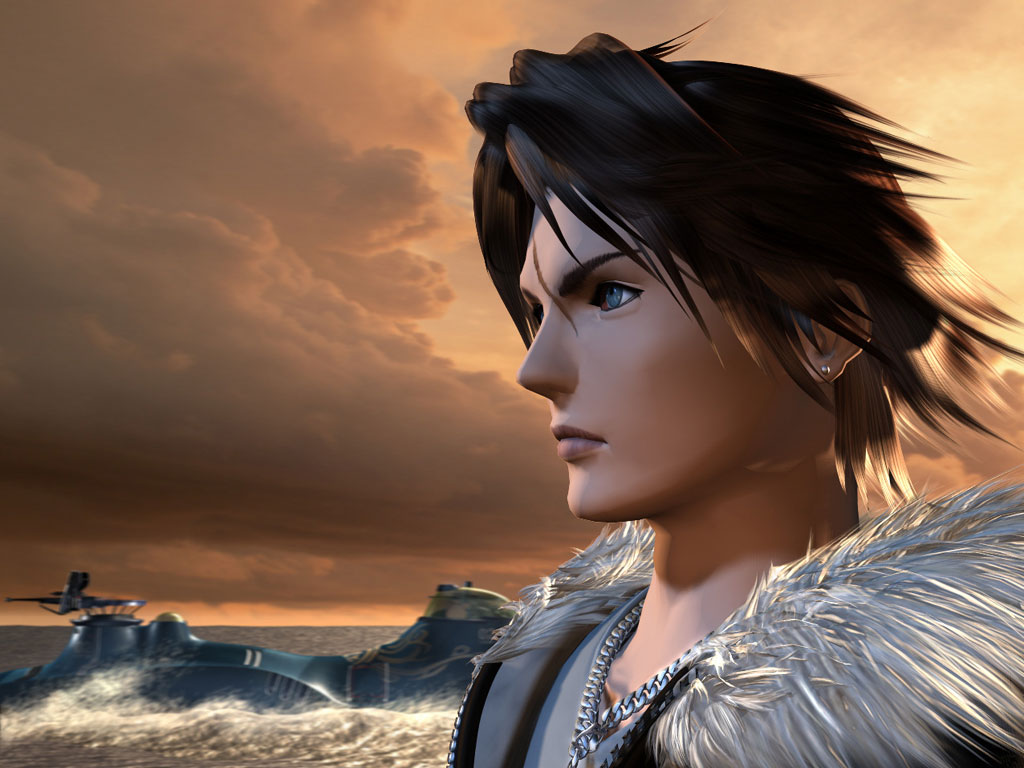
The story: Meet Squall, a stoic mercenary who seems to hate everyone in his life, particularly himself. Squall grows up in Balamb Garden, a training ground for child soldiers destined to join the mercenary group SeeD, alongside his arsehole rival Seifer and his patient instructor Quistis.
Along with fellow SeeD members Zell and Selphie, Squall goes on a mission to a city called Timber, where they help a resistance leader named Rinoa fight against the occupying army of Galbadia. Then they’re all given orders to assassinate the sorceress Edea (with whom the dickish Seifer has joined up) with the help of a sniper named Irvine.
The party’s assassination attempt fails, and eventually the six of them — Squall, Rinoa, Zell, Selphie, Irvine, and Quistis — get caught up in a war between Balamb and Galbadia. The conflict culminates in Squall’s group defeating Edea for real, only to discover that she’s actually pretty chill and was just being possessed by another sorceress called Ultimecia.
Turns out Ultimecia can possess any sorceress, including Rinoa, who — surprise! — is a sorceress herself. Ultimecia manipulates Rinoa — shades of FFVII here — and uses her to free the imprisoned body of Adel, another sorceress. Ultimecia wants to accomplish a state called Time Compression, where she will be the only living person on the planet. After a whole lot of drama, Squall and crew stop her.
Also, Squall and Rinoa kiss in space, the party starts a band, and Squall and crew occasionally travel back in time and inhabit the bodies of Galbadian soldier Laguna and his two best pals. This game contains multitudes.
The main villain: Edea, a sorceress. No, wait, it’s Adel, a sorceress. Err, nevermind, it’s Ultimecia, a sorceress. Although Ultimecia is incredibly powerful and comes very close to succeeding at her goal of compressing the world — all of Disc 4 takes place on a partially time-compressed planet of her making — her motivations remain unclear. She’s evil, and she wants to stop SeeD, and that’s about it.
Seifer, on the other hand, is a far more tragic villain — an unloved orphan whose stubbornness, arrogance, and recklessness prevent him from succeeding in SeeD. After bullying his classmates, failing to graduate, and generally screwing things up for himself in every possible way, Seifer winds up serving Ultimecia as her lackey.
Over the course of the game, he becomes more and more unhinged, his appearance growing disheveled to reflect his descent into depravity. As awful as he is, you just can’t help but feel sorry for him.
The gimmick: There are so many, but let’s talk about the Draw system. To use magic in Final Fantasy VIII, you have to collect it. Each spell is treated as an item, and you can collect different quantities of each, so you might have 90 Fires, 83 Cures, 12 Poisons and so on. There are a few ways to collect spells, but the main method is to “Draw” them from enemies. Everyone you fight carries a range of up to four different spells and during combat, you can use the Draw ability to steal those spells for yourself.
Then you can either use them or “junction” them to boost your stats, like strength or hit points, with the stat increase correlating to the number of spells you have. (99 Fires will give you a lot more extra HP than, say, 10.)
However interesting the system might sound on paper, it’s a tedious nightmare in practice. The problem is that using the Draw command takes up a character’s turn. Draw will generally get you between 1 and 9 of any given spell, so if you want to max out, you’ll have to spend turn after turn just standing around and stealing spells from enemies.
It takes forever and is not fun. And because your stat boosts are linked to the number of each spell you have, it actually punishes you if you use the magic you’re taking.
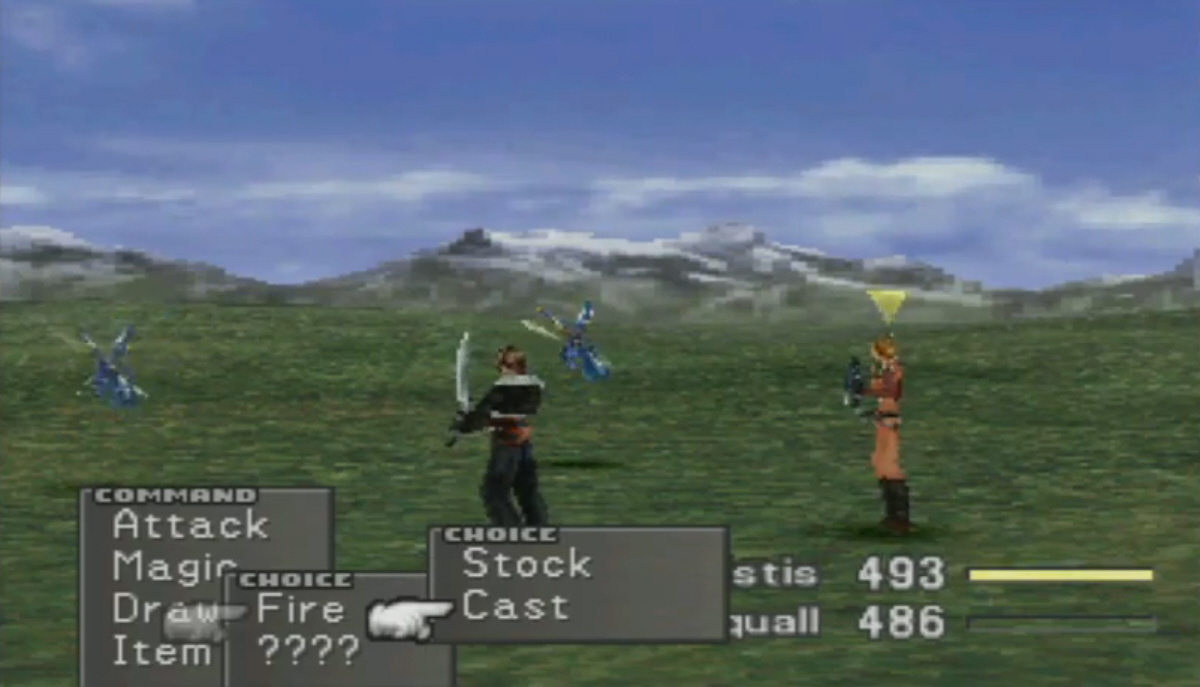
Oh, one more gimmick: All of your characters’ abilities come from summoned monsters called Guardian Forces (GFs) that you’ll collect throughout the game. Yes, this is a game about collecting GFs.
Best boss: Griever, Ultimecia’s GF and one of the final bosses of the game. In practice this guy is a pain in the arse, taking away your spells and whatnot, but lore-wise, he’s a manifestation of Squall’s perception of the “ultimate GF,” which I think is PRETTY COOL.
Most confusing boss: NORG, who finances SeeD and the Balamb Garden but also”¦ lives in the basement? And is really mad because SeeD is trying to kill sorceresses instead of make him money? And then turns into an egg and eventually hatches after you kill him? It’s best not to think too much about this plotline.
Worst boss: During a mission to capture the nasty President Deling, Squall and crew find themselves fooled by a decoy, who taunts them for a while before turning into a boss battle. For all of his bluster, though, you can kill him in one turn. Just use a Phoenix Down.
Best mini-game: Triple Triad, a brilliant, addictive card game that set a new bar for what RPG mini-games should look like. What’s cool about Triple Triad isn’t just the pace, the strategy, and the fact that you can play it against hundreds of random NPCs across the world. What’s cool is that it helps you in combat. Using special GF abilities, you can refine cards into items and magic, taking your hard-fought rare cards and using them to stomp even the most difficult bosses. Also, there’s an entire subplot surrounding a group of card sharks at Balamb Garden, and it ends with a fun little twist.
Worst part of this mini-game: The fact that the rules change based on your in-game region, and that you can accidentally carry those rules with you as you travel the world. As you play cards across the planet, you might find yourself spreading awful rules to everyone you come in contact with, like a bad case of chlamydia. Random, which automatically picks your hand from your library instead of letting you pick your own cards, is the worst offender.
Best character: Squall, who drives a lot of people crazy but is actually a fascinating dude. Final Fantasy VIII is, more than anything, a coming-of-age story, showing us Squall’s journey from an insecure loner to a somewhat less insecure romantic. Throughout the game, we’re treated to a non-stop barrage of Squall’s internal thoughts about everyone around him, which are about as irritating as it would be if you cracked into the head of any 17-year-old boy. It makes for some interesting character contrasts, and even if Squall’s mopiness can get insufferable, it also makes sense with his character.
Over the course of the game, Squall realises that he can’t live his life as a loner and needs to learn how to rely on other people. As he evolves, we the players learn what made him that way in the first place. He grew up in an orphanage and watched other families adopt his siblings, but nobody came for him. His closest friend and sister, Ellone, had to leave because people were worried about her powers of time manipulation (note: this is a Final Fantasy game), but nobody actually informed Squall of that, so he assumed she had abandoned him.
Replaying the game as an adult, I appreciated Squall’s growth as a character and his gradual love for Rinoa far more than I did when I was a mopey adolescent myself. I imagine many longtime Final Fantasy fans might feel the same way.
Worst character: Zell, a lunkhead who gets no such character development.
Best city: Esthar, a sprawling, futuristic metropolis that is protected by an invisible barrier but is nonetheless occasionally invaded by monsters.
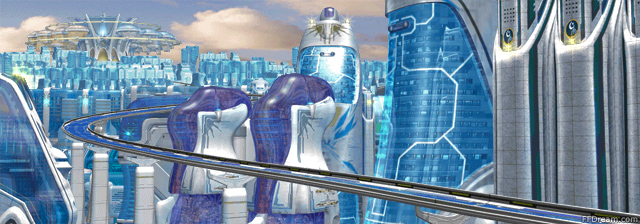
Fun fact: The Balamb Garden cafeteria is always out of hot dogs.
Best dungeon: Ultimecia’s Castle, a dungeon that’s unlike anything else in the game. When you enter Ultimecia’s Castle, your party will lose all of their abilities, and you’ll have to fight your way through bosses to gradually gain your powers back. It’s a challenging, satisfying gauntlet.
Best fan theory that isn’t actually true: Rinoa = Ultimecia, which producer Yoshinori Kitase shot down in an interview with me earlier this year. Runner-up: Squall’s dead, which Kitase also shot down. Sorry, fan theorists.
Most inexplicably bad map: In the city of Timber, early in the game, you can find a man who will let you see his map. This is what it looks like:
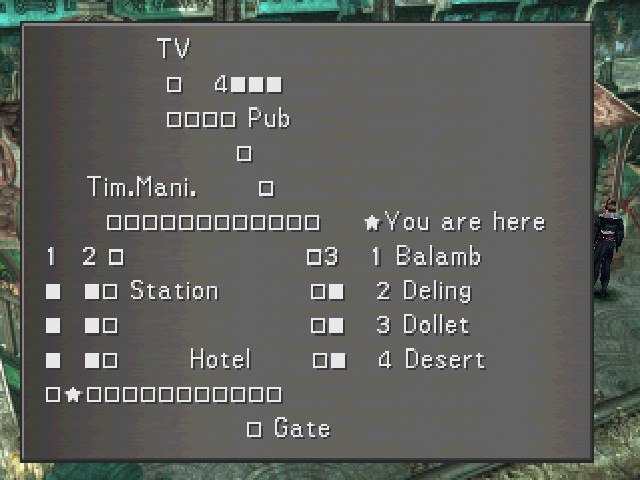
Via SomethingAwful forums
Best music: The Man With The Machine Gun
Most ridiculous looking character: Dr. Odine, whose character design I swear I’m not making up:
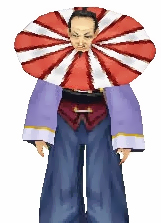
Best summon: Doomtrain, a train that is made out of doom.
Best plot twist: GFs actually erase your character’s memories. Specifically, they take up space in your brain where your memories should be. In other words, they cause CTE.
Best vehicle: About halfway through the game, Squall and crew will activate a special mechanism that uproots Balamb Garden from the ground, turning it into a mobile fortress. Then you can fly it around the map. That’s right, you can fly your school around the map. How can anyone dislike Final Fantasy VIII?
Meet Cid: This time, he’s the headmaster of Balamb Garden and husband to the sorceress Edea. At first he appears to be wise and benevolent, like a cross between Robin Williams and Dumbledore. As the game proceeds it becomes clear that he’s actually kind of clueless.
Best absurd minigame interlude: The part where you have to select instruments for all of your characters and”¦ start a band?
Best catchphrase: “…whatever.”
Love story that won’t make you want to dislodge your brain from your skull: Video games, as a general rule, don’t do romance very well. JRPGs especially. Yet Final Fantasy VIII‘s central love story is surprisingly competent. Because the entire game is built around Squall and Rinoa’s relationship, it winds up feeling very real — or about as real as a relationship can feel when it involves a man saving his girlfriend from being possessed by a time-travelling sorceress.
Does the game hold up? Yeah, mostly. The script has a few translation issues, and the Draw system never stops feeling tedious. You’ll also need a walkthrough if you want to figure out many of the game’s obscure secrets. The first time I played, I missed half of the GFs. Pro tip: Draw from every boss you find.
Next time: Shakespearean comedy…
This article was originally published on 31/12/17.
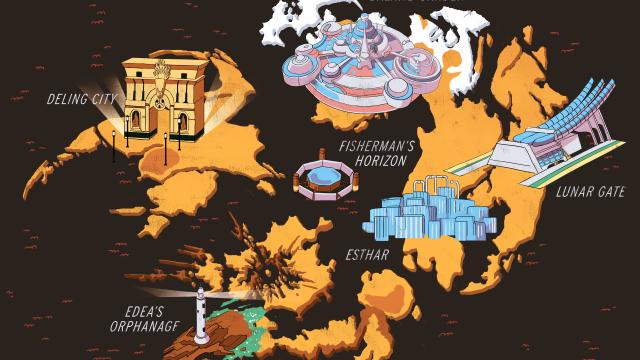
Comments
23 responses to “Final Fantasy 8 Retrospective: The Greatest Love Story”
I got my fun out of the game, the audiovisual presentation at the time was straight up wizardry. That said I didn’t like Squall or Rinoa and even post development they are people I want nothing to do with. Returning to the game later improved things, I can certainly recommend the game but greatest love story? Nah man.
Imo the greatest love story is ff9/ffx to be honest. No matter how people trash ffx, the story is pretty solid.
Bull.
FF7 has the greatest love story ever told.
End of story.
Half disagree. It was from Tifa’s side. Cloud spent way too much of the game half-believing to be Zack (hence his infatuation with Aeris) to show any realistic developments of his emotions towards Tifa.
I much prefer how Squall actually sorted through his feelings/trauma/etc to realise that what used to pass as his “personality” was fake and crippling and that admitting to himself that he was in love with Rinoa and that he cared for his friends.
Nevertheless, greatest love story in videogames is Tales of Symphonia’s.
FFVIII was my first FF. I think that’s why I have a very soft spot in my heart for the game. I’ve always enjoyed the story, even the first time I played in my teens. I found the juxtaposition of Squall and Laguna stories great.
The implications of Laguna being Squalls father were lost on me in my first play through, but I felt that it was interesting to see Squall learn to finally do what Laguna does implicitly: trust in your friends and you can accomplish anything.Final Fantasy VIII was my introduction to the series, as Icwatched my friend play it, going through it inch by inch in order to unlock every single GF and weapon. I tried playing it and realised I didn’t have that sort of patience.
Luckily, I picked it up on the Steam sales, which allow you to out in all sorts of game breaking modifications, such as unlimited spells and health. Really excited to just be able experience the story with spending days of my life grinding
The unlimited spells cheat is actually a bit of a poisoned chalice. It kits all of your characters out with an inventory full of, essentially, junk and leaves you with no room to put the better, more powerful spells later.
I enjoyed FFVIII for what it was back in the day. Specially hunting the GF’s and the whole GF boost which made GF summoning a mash the button mini game of sorts =P As well as gaming the Tetra Master regions to remove Random (the Moon lab is still the most cancer of all areas though and its annoying because IIRC one of the rare GF cards was only obtainable there xD)
The whole difficulty going up as you leveled was also a nice touch but the Junction system whilst interesting was so thoroughly abusable (Card and Devour are your friends) and made magic pretty much unuseable by the very nature of penalising you for reducing your stack of spells.
Harsh criticism of Zell 🙁 He was awesome! He was a carefree, fist fightin’, hot dog lovin’ dude!
I know I’m one of the few people who loved FF8, and it took me a while to figure out why: FF8 had one of the most coherent plots of all the Final Fantasies (from what I can remember, and what I played). Certainly more coherent than the newer FF’s (MMO’s not included)
Zell didn’t need character development. Ma Dincht raised him right, and he wasn’t an emo basket-case like the rest of the gang (except Irving). Granted, she still should have slapped him for that haircut. We all know the worst character is Raijin. Like, y’know lol hahahaha y’know! Ugh…
And screw Seifer. Take your “I can’t understand why being a colossal arsehole didn’t make people like me, so I’m gonna willingly help wipe out existence out of spite. Also I apparently want to bang the woman who raised me” B.S to an early 90s anime, where it belongs.
Final Fantasy 8 has a weird place in my heart. I rented it when I was still youngish and I had the attitude that I needed to finish it as fast as possible. So I ran away from every fight,skipped the draw tutorial and didn’t understand the combat system at all. I managed to get to the last boss at level 29. Couldn’t beat her though. What I learned later when i came back to it years later was the mobs levelled with you. Which was how I was able to do what I did. I finished it the second time quite easily when my characters had 100 death on their weapons etc. So while I get it now and enjoyed it, that first experience will always haunt my memories
FFVIII strangely has one of the best Final Fantasy stories but it needs a lot more time to unfold compared to other FF or JRPGs.
I would add a further criticism of the “Draw” system – not only is it tedious but it also makes the game very easy
Gun Blade, not Sword Gun, sheesh
This is my second fave ff, I guess because I played it when I was youngish. The setting was great to me and the music. ..I can still hear it in my head. Good times.
I really like FFVIII. Something not mentioned here is how the strange gameplay mechanics can be ‘abused’ by people experienced with the game. You can use GF Magic Refine skills along with the skill that lets you refine Triple Triad cards into items pretty early in the game to get access to late game magic and skills. There are a ton of optional objectives / side quests too, like killing the robo spider. I’d say it’s one of the best FF games for replayability.
FFVIII’s Junction is the most abusable system in the whole of the series only coming 2nd in my opinion to the Skyrim like system of FFII =P (I mentioned it on my post but for some reason Kotaku puts all my posts on moderation everytime i Edit now so it’s probably not even showing… >.>)
Once you got the skills Card and Devour you could pretty much harvest magic, beat monsters without gaining exp and get mats to swap to more spells. Insanely abusable once u get the proper cards from Triple Triad wins as well. The only issue was really the fact that as unique and fun as the system was it really penalised you for using Magic. It’s either physical attacks or GF’s.
Or if you know what you’re doing, perma-limit breaks.
Including the game itself. I liked the story of FF8 because crazy time travel stories are my jam no matter how bad they are but the gameplay itself was broken as all get out, especially the whole “Levelling up only makes it worse for you” concept.
The love story side of it does make you want to dislodge your brain from your skull though. Twilight may just be the better love story in this case…
I always have liked FFVII significantly less than your average gamer (even though I like it quite a bit). The reason for that is twofold: I started playing FFs in the Super Nintendo, including the fantastic FFVI and I had a late entry to the Playstation which, for reasons, caused me to play FFVIII before VII.
In my eyes, FFVII’s story was a huge step down from both VI and VIII. FFVI’s is more epic and FVIII’s more deeply personal and complex, while FFVII sat in the middle. Same for the graphics; neither the charming and awesome pixel art of FFVI’s late SNES vintage, nor the immensely improved polygon 3D graphics of VIII. And the gameplay? Neither the traditional and familiar FF gameplay polished to perfection in VI nor the aggressively innovative one of VIII.
In short, FFVII is a transitional phase, an adolescence. Skipping its place in the progression stopped me from growing along with it and prematurely “matured” me, so for all the wonders and things that FFVII did right, I was never able to see it as anything else than a gangly, awkward teenager.
What I am trying to say, is that FFVIII is a superior game to FFVII (though not flawless at all) in almost every sense. FFVII is just looked at more indulgently, with the rose-tinted glasses one uses to look at one’s childhood or early teens.
Is this really happening? 😀 Finally a retrospective article on the internet giving FF8 the praise it deserves, instead of sites usually posting an almost automated, predictable article about one of the other FFs. FF8 is like an unfinished masterpiece. I believe Square have plans to wait for VR to really get somewhere, and then either remake or side stories for FF8, as it has tons of amazing places that would be awesome to visit in first person 3D, which can’t really be said for FF7 (suits a traditional remake).
As for the draw/magic stocking situation, I think they hit a cultural funny bone here- eastern cultures seem to care less about perfection and tend more to accept certain things for the reality behind what they are- so having an imperfect amount of magic in stock (less than the 100 limit for any magic) is something I believe was not an issue in Japan etc.
FF8’s music in particular also deserves major praise. Back in a time when FFs were silent movies, it could be said that there was an extra onus on Nobuo Uematsu to compose an amazing soundtrack- and boy did he deliver in FF8, with pieces that absolutely capture the emotion of FF8’s many great moments.
Best line of dialogue: “I’m not having anybody talk about me in the past tense!” – Squall.
Personal favourite FF. 20 years on, Triple Triad is still unmatched.
I played this for the first time on PC. I even still have the original boxed copy. It was janky, buggy, and had a terrible MIDI soundtrack, but I loved it all the same. I can’t wait to take it for another ride on the Switch.